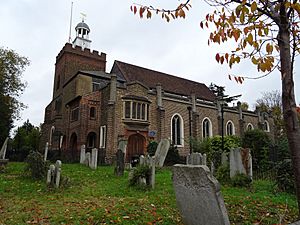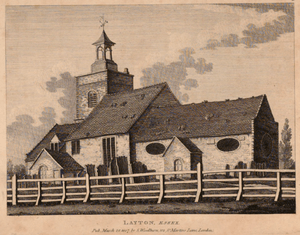St Mary's Church, Leyton facts for kids
Quick facts for kids St Mary with St Edward and St Luke's Church, Leyton |
|
|---|---|

A view of St Mary's Church from the southwest.
|
|
| Location | Church Road, Leyton, London, E10 5JP |
| Country | England |
| Denomination | Church of England |
| Website | https://saint.church/leyton |
| History | |
| Status | Active |
| Dedication | Mary the Virgin |
| Architecture | |
| Functional status | Parish church |
| Heritage designation | Grade II* listed |
| Designated | 27 May 1954 |
| Years built | 1658-1932 |
| Administration | |
| Archdeaconry | West Ham |
| Diocese | Chelmsford |
St Mary's Church is a historic Church of England parish church in Leyton, East London. It is also known as the Parish Church of St Mary with St Edward and St Luke, Leyton.
Although a church has stood on this spot for over 800 years, it has been rebuilt and changed many times. The oldest parts you can see today were built in 1658. Because of its long and interesting history, it is a Grade II* listed building. This means it is officially recognized as a very important building in England that must be protected.
The church follows the Evangelical tradition within the Church of England.
Contents
History of St Mary's Church
The story of St Mary's goes back to medieval times. Records show that a church existed here around the year 1200.
Early Beginnings
The famous Domesday Book of 1086 mentioned two priests living in Leyton, which suggests there was already a church here. The first clear record of the church is from about 1200. At that time, it was given to a monastery called Stratford Langthorne Abbey.
The first known vicar, a type of priest in charge of a parish, was recorded in 1254. One of the most famous people connected to the church was John Strype. He served as the local priest for 68 years, from 1669 until he died in 1737. The priest before him, Samuel Keme, was also a soldier in the First English Civil War. It is said he sometimes preached his sermons while still wearing his military jacket!
Rebuilding and Expanding
The original medieval church was very small. Its foundations were discovered in 1962 and showed it would fit inside the main part of the modern church. Over the centuries, the building was changed and made bigger many times.
17th and 18th Century Changes
By 1658, the old bell tower was in danger of falling down. It was replaced with the brick tower that still stands today. A new section, called the north aisle, was also added in brick.
In 1693, the chancel (the area around the altar) was rebuilt because it was too small for people to receive Holy Communion. Later, in 1711, a gallery was built at the back of the church. Another gallery was added in 1817 just for the boys from the Sunday school.
The Big Makeover of 1822
Even with the new galleries, the church was still too crowded. The vicar complained that many people had to stand in the aisles during services. Plans to make the church bigger had been made years earlier but there wasn't enough money.
Then, in 1822, a mysterious person known only as "The Old Parishioner" gave a huge donation of £1,000. Other people in the parish also gave money, and work began. A new south aisle was built with unique Y-shaped patterns in the windows. The whole church got a new roof, and the tower was made taller. A special dome-shaped structure, called a cupola, was moved from a nearby mansion and placed on top of the tower.
Victorian and Modern Updates
More changes were made over the next century. A new window was added in 1853, and a new baptistery (where baptisms happen) was built in 1884.
In 1929, a major project began to make the church even bigger and stronger. The main part of the church, the nave, was made longer. The old wooden structures were replaced with strong concrete. After being damaged by bombs in World War II, the church was repaired in 1951. A fire in 1995 led to more changes, including creating a small chapel under the tower.
Inside the Church
St Mary's is filled with interesting features and memorials that tell the story of Leyton's past.
Memorials to Famous People
Inside the church, there are many monuments dedicated to important people who once lived in Leyton. These include memorials for:
- Sir Michael Hicks (1543–1612) and his son, Sir William Hicks.
- William Bosanquet, whose monument was carved by the famous artist John Flaxman.
- Other important local figures like Sir John Strange, Sir Henry Cheere, and Sir Robert Beachcroft.
An oak screen and a carving of The Last Supper were added in 1920 as a memorial to those who died in World War I.
Joining with Other Churches
For hundreds of years, St Mary's was the only Anglican church in Leyton. As the area grew, more churches were built. In recent times, some of these churches closed, and their parishes joined with St Mary's.
St Edward's Church closed in 1968, and St Luke's Church closed in 1982. The people from these churches became part of the St Mary's community. This is why the church is now officially called St Mary with St Edward and St Luke.


